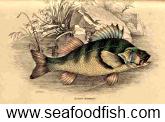MODERN COOKERY FOR PRIVATE FAMILIES
By Eliza Acton (1845)
TO CHOOSE FISH
The cook should be well acquainted with the signs of freshness and good condition in fish, as they are most unwholesome articles of food when stale, and many of them are also dangerous eating when they are out of season The eyes should always be bright, the gills of a fine clear red, the body stiff, the flesh firm, yet elastic to the touch, and the smell not disagreeable When all these marks are reversed, and the eyes are sunken, the gills very dark in hue, the fish itself flabby and of offensive odour, it is bad, and should be avoided.
Eels should be alive and brisk in movement when they are purchased, but the 'horrid barbarity,' as it is truly designated, of skinning and dividing them while they are so, is without excuse, as they are easily destroyed 'by piercing the spinal marrow close to the back part of the skull with a sharp pointed knife or skewer. If this be done in the right place all motion will instantly cease.' We quote Dr. Kitchener's assertion on this subject; but we know that the mode of destruction which he recommends is commonly practised by the London fishmongers. Boiling water also will immediately cause vitality to cease, and is perhaps the most humane and ready method of destroying the fish.
Lobsters, prawns, and shrimps, are very stiff when freshly boiled, and the tails turn strongly inwards; when these relax, and the fish are soft and watery, they are stale; and the smell will detect their being so, instantly, even if no other symptoms of it be remarked. If bought alive, lobsters should be chosen by their weight and 'liveliness.' The hen lobster is preferred for sauce and soups, on account of the coral; but the flesh of the male is generally considered of finer flavour for eating. The vivacity of their leaps will show when prawns and shrimps are fresh from the sea.
Oysters should close forcibly on the knife when they are opened: if the shells are apart ever so little they are losing their condition, and when they remain far open the fish are dead, and fit only to be thrown away. Small plump natives are very preferable to the larger and coarser kinds.
TO CLEAN FISH.
Let this be always done with the most scrupulous nicety, for nothing can more effectually destroy the appetite, or disgrace the cook, than fish sent to table imperfectly cleaned. Handle it lightly, and never throw it roughly about, so as to bruise it; wash it well, but do not leave it longer in the water than is necessary; for fish, like meat, loses its flavour from being soaked. When the scales are to be removed, lay the fish flat upon its side and hold it firmly with the left hand, while they are scraped off with the right; turn it, and when both sides are done, pour or pump sufficient water to float off all the loose scales; then proceed to empty it; and do this without opening it more than is absolutely necessary for the purposes of cleanliness. Be sure that not the slightest particle of offensive matter be left in the inside; wash out the blood entirely, and scrape or brush it away if needful from the backbone. This may easily be accomplished without opening the fish so much as to render it unsightly when it is sent to table. When the scales are left on, the outside of the fish should be well washed and wiped with a coarse cloth, drawn gently from the head to the tail. Eels to be wholesome should be skinned, but they are sometimes dressed without; boiling water should then be poured upon them, and they should be left in it from five to ten minutes before they are cut up.
Classic Seafood Recipes & Fish Recipes
How to choose, clean, skin, bone, fillet and cook fish and other seafood
FISH INFORMATION
Eliza Acton
Catharine Beecher
Eliza Leslie
Mrs. D. A. Lincoln
Fannie Farmer
The Settlement
Please feel free to link to any pages of SeafoodFish.com from your website.
For permission to use any of this content please E-mail: james@seafoodfish.com
Original material copyright © 1990 - 2017 James T. Ehler unless otherwise noted.
All rights reserved. You may copy and use portions of this website for non-commercial, personal use only.
Any other use of these materials without prior written authorization is not very nice and violates the copyright.
Please take the time to request permission.

